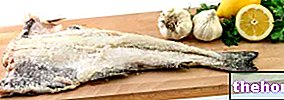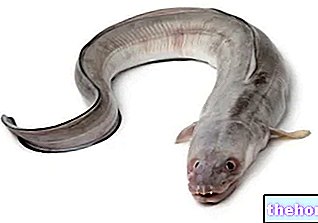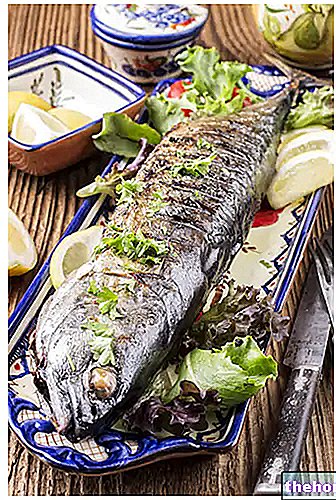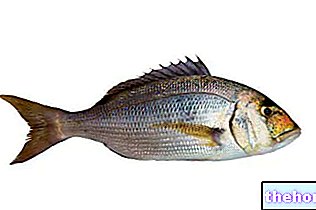Generality
The puffer fish it is a typically oriental fishery product and extremely expensive, as it is valuable. This characteristic depends not only on the pleasantness of its meat, but above all on the fact that the processing of fish requires a skill that few have in their work curriculum;

In Japan, the operators who are allowed to process the meat of puffer fish are all provided with a specific license: moreover, the sale of the non-processed animal is totally forbidden to final consumers. This does not deny the population to supply themselves with puffer fish. through amateur fishing; obviously, most of the deaths from poisoning (however quite rare and not even remotely comparable, for example, to those from mushrooms) occur within the domestic walls of the Japanese population.
Outline of Biology
The puffer fish belongs to the Tetraodontidae family, which includes about 80 species distributed mainly in the temperate or tropical seas (Indian and Pacific Oceans); there are some species resident in the Atlantic Ocean.
In Japan, puffer fish is called Fugu or Torafugu, probably synonymous with the scientific name that indicates a particular genus of puffer fish, that is Takifugu; of this whole, the species most likely used for food purposes is the rubripes; the binomial nomenclature of this puffer is Takifugu rubripes.
The puffer fish has no natural predators, or rather, it shouldn't have any. He defends himself by swelling and becoming difficult to bite; moreover, it is covered with thorns and its flesh is equipped (as anticipated) with a deadly poison. It feeds on molluscs (gastropods and bivalves), crustaceans and corals which it crumbles by means of its powerful teeth (similar to a beak).
Symptoms of Intoxication
Puffer poison is a liquid containing an extremely dangerous and potentially deadly toxin. It is a neurotoxin, which is an element that interferes with the nerve conduction of those who absorb it. To be precise, it is called tetradotoxin (TTX); chemically, it is water-soluble (water-soluble) and thermostable (heat-resistant), which means that, even by boiling the puffer fish, if the toxin has contaminated the meat, it remains non-edible and potentially fatal. It is not yet clear how the production of TTX occurs in the viscera (especially liver, eggs, intestines) and in the skin of the puffer fish, but it has been hypothesized that it may be the result of the bacterial metabolism of microorganisms belonging to the Genera Vibrio spp. And Pseudomonas spp. On the other hand, its toxicity is quite clear; this neurotoxin has shown a potential 1,200 times higher than potassium cyanide and acts by paralyzing respiratory muscles and the heart until death.
NB. Puffer fish is not the only organism containing TTX, molluscs and crustaceans are also involved such as: Jania spp, Astropecten spp., Veremolpa scabra, Charonia sauilae, Rapana venosa, Demania toxica, Yongeichthys criniger And Hapalochlaena maculosa. This would suggest that the bacterial contamination hypothesis may be reliable, further supported by the very low levels of toxin present in farmed puffers. However, the benefit of the doubt remains, needed to keep alert levels high.
Symptoms of puffer poisoning are quite similar to those of other marine biotoxin poisoning and consist of dullness, paralysis, vomiting, diarrhea, convulsions and cardio-respiratory block. However, the toxic potential varies by species. object, geographic location, gender and season.
Since some traces of the poison are also present in the meat, a Community legislation, that is the EC regulation n. 853/2004, prohibits the sale and marketing of puffers (any specimen of the Tetraodontidae family) throughout the EU, where instead there is a health control for fish products imported from EU countries.
ATTENTION BUT! From the Suez Canal (in Egypt, which connects the Red Sea with the Mediterranean Basin) the migration of non-native species occurs continuously, including some belonging to the pufferfish family. The body responsible for their recognition is the veterinary one supported by the ASL which, thanks to reports, has documented various similar catches (from 2003 onwards) in the regions: Lazio, Campania, Sardinia, Sicily and Puglia. The exclusion of these fish from the national trade (from the 1980s) has eliminated the cases of intoxication in Italy. Unfortunately, there have also been some very dangerous attempts at food fraud; this provided for the use of puffers to replace the well-known monkfish (or monkfish) but, fortunately, the attempt was thwarted by the competent authorities.
Gastronomic notes
Puffer fish is the subject of numerous culinary preparations, raw and cooked, even if, for obvious reasons, they are not particularly well known in Italy.
The best known, probably, is fugu sashi or fugu sashimi, that is a type of sushi; the characteristic of this preparation is that, unlike those based on salmon, sea bream, tuna etc., fugu must be cut much thinner (probably due to the consistency of the meat). How not to mention, then, the stewed puffer fish or fuguchiri, and the fried fugu or fugu karaage. It is curious to learn that, despite being a food forbidden in the Emperor's diet due to the risk of intoxication, the puffer fish prepared with great skill must have a percentage of TTX sufficient to inform and slightly numb the diner's jaws.
Fish, Molluscs, Crustaceans Anchovies or Anchovies Garfish Alaccia Eel Lobster Herring Lobster Whitebait Bottarga Sea bass (Sea bass) Squid Canocchie Scallops Canestrelli (Sea scallops) Capitone Caviar Mullet Monkfish (Monkfish) Mussels Crustaceans Dates Sea Fruits Fish Flour Fauna Fish stock Prawns Crabs Spider crab (Granceola) Halibut Sea salad Lanzardo Leccia Sea snails Prawns Cod Molluscs Octopus Hake Ombrina Oysters Sea bream Bonito Pangasius Paranza Anchovy paste Fresh seasonal fish Blue fish Puffer fish Swordfish Plaice Octopus (Octopus) Hedgehog of Sea Amberjack Salmon Sardines Sardines Scampi Cuttlefish Mackerel Sole Stockfish Surimi Sushi Telline Tuna Canned tuna Mullet Trout Fish roe Bluefish Clams OTHER FISH ARTICLES Categories Alcoholic Food Meat Cereals and derivatives Sweeteners Sweets Offal Fruit Dried fruit Milk and derivatives Legumes Oils and fats Fish andpeach products Salami Spices Vegetables Health recipes Appetizers Bread, Pizza and Brioche First courses Second courses Vegetables and Salads Sweets and Desserts Ice creams and sorbets Syrups, liqueurs and grappa Basic preparations ---- In the kitchen with leftovers Carnival recipes Christmas Light diet recipes Women's, mom's and dad's day recipes Functional recipes International recipes Easter recipes Celiac recipes Diabetic recipes Holiday recipes Valentine's Day recipes Vegetarian recipes Protein recipes Regional recipes Vegan recipes




























